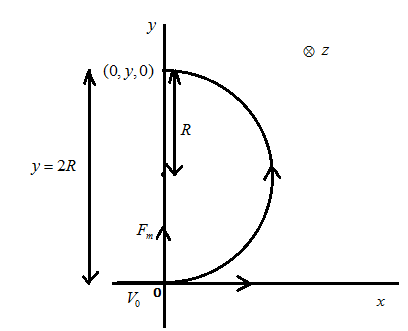
A particle charge per unit mass
(A)
(B)
(C)
(D)
Answer
448.2k+ views
2 likes
Hint :The particle charge per unit mass is given by
Complete Step By Step Answer:
Let us draw the suitable diagram as per our knowledge of forces acting on the particle in the magnetic field which is directed inside the plane denoted by
The particle is starting to move from the point

Here we have to use the concept of Lorentz force as
But, as the force
Now from equating
Now we have to find out the value of
For this we have the radius of the circular path along
Thus, we have calculated the value of
The correct answer is the option C.
Note :
Here, we have used the concept of the Lorentz force acting on a charged particle. It is defined as the force exerted on a charged particle
Complete Step By Step Answer:
Let us draw the suitable diagram as per our knowledge of forces acting on the particle in the magnetic field which is directed inside the plane denoted by
The particle is starting to move from the point

Here we have to use the concept of Lorentz force as
But, as the force
Now from equating
Now we have to find out the value of
For this we have the radius of the circular path along
Thus, we have calculated the value of
The correct answer is the option C.
Note :
Here, we have used the concept of the Lorentz force acting on a charged particle. It is defined as the force exerted on a charged particle
Recently Updated Pages
Master Class 12 Business Studies: Engaging Questions & Answers for Success

Master Class 12 English: Engaging Questions & Answers for Success

Master Class 12 Social Science: Engaging Questions & Answers for Success

Master Class 12 Chemistry: Engaging Questions & Answers for Success

Class 12 Question and Answer - Your Ultimate Solutions Guide

Master Class 11 Economics: Engaging Questions & Answers for Success

Trending doubts
Draw a labelled sketch of the human eye class 12 physics CBSE

a Tabulate the differences in the characteristics of class 12 chemistry CBSE

Which one of the following is a true fish A Jellyfish class 12 biology CBSE

Why is the cell called the structural and functional class 12 biology CBSE

Differentiate between homogeneous and heterogeneous class 12 chemistry CBSE

Write the difference between solid liquid and gas class 12 chemistry CBSE




